Aaron’s Top Games of 2015

Aaron is ripping off Jon in an attempt to create the illusion of standard layouts between our posts.
Like other members of Fuchsia, I had to make a gaming sprint somewhere around mid-December just to catch up on titles I knew were going to be discussed during the big GoTY podcast. I still missed many of the entries in our Final List for 2015, but it feels like I played more new games than in any previous year.
I went to the trouble of naming runners-up for all of the award categories just to over-complicate things.
- Most Feels
- Biggest Disappointment
- Funniest
- Prettiest
- Most Addicting
- Best Early Access Game
- The One That Got Away
- Of Course I’ll Rebuy That!
- Shame
- That Beat Tho’
- Quiplash
- Shovel Knight: Plague of Shadows
- Heroes of the Storm
- Rocket League
- The Legend of Zelda: Majora’s Mask 3D
- Game of Thrones – A Telltale Games Series
- Destiny: The Taken King
- Fallout 4
- Undertale
- Super Mario Maker
First up, the awards:
Most Feels: Game of Thrones – A Telltale Games Series
Runner-up: Emily is Away
I’ve mentioned during podcasts that Game of Thrones – A Telltale Games Series delivers a massive amount of one specific feel: frustration. Fans of the books and show might roll their eyes and ask what else could be expected, but honestly I wasn’t ready to be so thoroughly discouraged by the midpoint of the game’s first season. Main characters are dying right out of the gate in episode one, and from there on you feel like every decision is just making things so much worse, no matter what you choose. Episodes mostly follow characters talking about how screwed they are, coming up with a plan to try to unscrew themselves, and then you (barely) participate as said plan goes all to hell and they end up even more screwed. I wanted to be excited when a second season was announced, but so far Telltale has made it clear that these games are only ever going to offer you a part in the complete and total ruination of House Forrester.
Meanwhile, the main feel delivered by Emily is Away is nostalgia. The interface, lifted straight from the glory days of Windows 95 and AIM, acts as an impressive time machine for anyone who lived through that particular era. But more surprising than the effectiveness of the aesthetic is how the conversations you have with your virtual chat partner very eerily match, if not only in tone and theme but sometimes exact wording, conversations many of us had back in those days (something I’ve confirmed with friends and colleagues). In the sense that I couldn’t relate to Gone Home‘s story because I was never a lesbian in the late 80s/early 90s, I can absolutely relate to Emily is Away, especially given how accurately the dialogues you have and the situations you talk through with Emily reflect ones I’ve had myself. I found myself getting up and pacing around during the chats, much like 20-something me did so long ago.
Biggest Disappointment: Mighty No. 9
Runner-Up: Oceanhorn: Monster of Uncharted Seas
Oh, Mighty No. 9, you are going to be my biggest disappointment of 2015 and 2016. I fully regret backing this, and not just because I went overboard and kicked it over $100 (I blame the whisky, which made me think the project would yield a game as good as Mega Man 9 or 10). Keiji Inafune doesn’t seem to have any sort of project management skills or the ability to gauge how much work it would actually take to deliver a feature. The Kickstarter campaign offered a very impressive assortment of stretch goals in exchange for as much cash as gamers could part with – a little too impressive, actually, as Comcept was ultimately committed to delivering all of the following:
- Several additional stages and characters over the original pitch
- Various game modes including
- Boss Rush
- Turbo
- New Game Plus
- Challenge
- Online Co-Op (which is not a small undertaking to add to anything, ever)
- An optional retro soundtrack and effects (twice as much work for the audio engineers!)
- Releases on
- PC
- Mac
- Xbox 360
- Xbox One
- Playstation 3
- Playstation 4
- Wii U
- PS Vita
- 3DS
Funded on September 2nd, 2013 with an original estimated release date of April 2015; if you can believe it, a year and a half ended up not being long enough to deliver all of that on nine platforms. Inafune must think that the answer to every problem, including having bitten off way more than he could chew to begin with, is to just keep throwing money at it, so an additional payment website was up the moment the Kickstarter closed and no opportunity was ever missed to hit gamers up for contributions or to remind people who’d already backed the project that they could send additional funds. While development slogged along, Inafune would also talk up how he wanted tie-in manga, anime, TV dramas, and a live action movie for Mighty No. 9, and then eventually go on to start two other Kickstarters for a game and anime based on a spin-off idea. This move not only angered people because his first project was still unfinshed, but also because he didn’t even need the crowdfunding anyway as he’d already gotten publishing deals for these new ventures. I think at this point it’s painfully obvious why Capcom wasn’t making new Mega Man games.
Oceanhorn: Monster of Uncharted Seas was a mobile game, and I didn’t know that going in. I saw it crop up on a gaming blog somewhere, heralded as a Zelda-like adventure made by a developer who fully admitted where the inspiration came from, and that got my attention. Short videos showcased the game as having a Wind Waker-like art style and an isometric presentation, and I liked everything I saw. Ultimately, it was extremely bland. The issue I have with most mobile games is that they always have to be bland to an extent so that they jive with touch controls and short play sessions; couple that with the game not really explaining what I should be doing or where I should be going, and I very quickly lost interest.
Funniest: Undertale
Runner-up: Quiplash
Undertale boasts solid writing and characters that are genuinely funny on their own, each having well-developed personalities that drive their interactions and create organic-feeling humor. The character designs and music will often come together to deliver some good laughs, and the gameplay constantly slips jokes in everywhere, to the point of where humor is just a permanent facet of the interface. The actions you can choose during each round of combat (which are specific to the monster you’re facing) regularly include unorthodox options such as “Flex” and “Don’t Pick On”, and scenario text describing what’s happening as a result of the action you took is almost always funny. Combat is conducted through skill-based mini-games that include appropriately bizarre elements, further fleshing out the oddness of every interaction you have. I found myself continuously smiling and outright laughing during most of the time I spent with this game.
Quiplash gets the runner-up nod for this category since most of the humor comes from the players themselves. This game was a big hit at all of the social gatherings I attended in the second half of 2015, and that goes beyond just parties with close friends. I brought it along for Christmas at my fiancée’s parents’, and her extended family enjoyed it just as much as the guys at Jon’s bachelor party had. Where I see this game succeeding is in its versatility, as the prompts are mostly written in a way that allows for the players to control how off-color the humor gets. I’ve heard a number of people tell stories about either having to dodge the suggestion of a game of Cards Against Humanity during family get-togethers for fear of angering/alienating/scarring relatives, or actually ending up breaking it out only to have their parents or grandparents excuse themselves from the table at some point. Fuchsia proved a few times over that Quiplash can be as terrible/awesome as CAH, while during Christmas I saw it function perfectly fine in a family setting.
Prettiest: Halo 5: Guardians
Runner-up: Destiny: The Taken King
Both games offer amazing environments that I really enjoyed exploring and just getting lost in. While Destiny’s story and setting demand that every area you visit be ruined by ancient war, Halo’s levels offer the variety of (both intact and starting-to-blow-up) UNSC ships, a rocky Covenant planet, an ancient, grassy (non-ruined!) Forerunner planet, and various outposts and colonies in mild and snowy climates. I found myself stopping mid-play in both games just to look around and admire the scenery, but while the abundant urban decay in Destiny is interesting, it is nice to visit virtual locales that don’t entirely look like certain parts of Philly once in a while, so Halo gets my favor here (although I do love Destiny’s take on the the moon and Venus). Halo also edges out Destiny on character designs, but only just so. Although I’m not crazy about its confusing-to-look-at, constantly shifting and twisting Promethans, I was equally not as crazy about Destiny’s confusing-to-look-at, constantly shifting and twisting Taken versions of its existing creatures, so they cancel out on that. The digital faces in Halo 5 are starting to approach what I was hoping we’d see more of after L.A. Noir, while faces on humanoid characters in Destiny are decent, but not quite as good. We all know the real deciding factor here is which game has the better digital Nathan Fillion, and Halo wins that as well, but again, only just barely. Cortana’s current form, introduced in Halo 4, is still my favorite from the series so far, and wasn’t really altered for the fifth game aside from the addition of a suit of armor to reflect the change to her role in the narrative. Destiny’s Ghost isn’t quite as appealing, but still a welcome companion whether he sounds like Peter Dinklage or Nolan North.
Most Addicting: Destiny: The Taken King
Runner-up: Rocket League
Despite losing (just barely!) to Halo 5 for graphics, I certainly played a lot more Destiny. Once the campaign was wrapped up, I did something I’ve never really done with a Halo game: I put it back on the shelf. I found myself coming back to Destiny weekly, even nightly, just enjoying how its solid gameplay always offered up plenty to do whether I was alone or teamed with friends.
Rocket League is the runner-up here only because I happened to play way more Destiny. That said, I played a ton of Rocket League, as its five minute match durations and addictive gameplay made it a very solid ‘just one more round’ kind of title. I found myself enjoying it whether I was in a close match or on either side of a horribly one-sided affair; although being on the losing team is frustrating, the randomness of players grappling with the game’s controls keeps it exciting since things could turn around – or just turn hilarious – at any moment.
Best Early Access Game: Ultimate Chicken Horse
I’ve been avoiding early access games for a while now. Jon loaded up Ultimate Chicken Horse during Extra Life for what I considered to be one of the major highlights of the whole marathon, so it gets my vote. It just needs more of… everything. I like the direction in which it’s heading, and am looking forward to seeing its full release.
No runner-up, here.
The One That Got Away: The Witcher III: Wild Hunt
Runner-up: Splatoon
I actually started the first Witcher earlier last year, but didn’t stick with it very far past the game’s opening. By the time the third game was due out, I’d talked myself out of jumping on it mostly from a desire to at least try both of the previous games first, and also because I was simultaneously buried in Grim Fandango: Remastered and looking for the next Game of Thrones episode from Telltale. It sounded like CD Projekt Red did everything right with their latest effort, from building a solid game, which I hear is a blast to play, down to providing some free DLC and excellent support. I’m looking forward to this one… some day.
Splatoon was the surprising runaway hit for a lot of publications for 2015. I remember reading about it needing some more variety at launch, but I believe that was solved with a few free content updates. Other than that, it looks like a decent competitive team game. I get the feeling this one won’t have a long shelf life, what with the NX on the way, so it might be something I need to jump on sooner than later.
Of Course I’ll Rebuy That!: The Legend of Zelda: Majora’s Mask 3D
Runner-up: Grim Fandango: Remastered
The Legend of Zelda: Majora’s Mask 3D ticks most of the boxes for a competent remake. It boasts some upgraded character models and somewhat-nicer textures in some places, and also takes a few steps toward leveling out the sometimes-crushing difficulty of the original release by reworking the boss battles and attempting to flesh out the in-game quest tracker. The boss battles feel a little too easy now, meanwhile the quest tracker didn’t end up nearly as robust as I was hoping for, requiring you to constantly check in with the kids in Clock Town until they randomly add quest threads to your journal (which wouldn’t really give you much more information on what to do). The game is presented in full stereoscopic 3D, which I enjoy, although as with Ocarina of Time 3D some of the camera angles the game throws your way just aren’t very well suited to it. Also, I often find myself disappointed when these remakes and re-releases don’t do anything for the game’s audio, and Majora’s Mask 3D seems to feature all the same exact MIDI songs and low-fi sound effects from the title’s original release on the N64.
Grim Fandango’s biggest problem always was, in my opinion, its use of 3D graphics instead of utilizing a 2D presentation more common to the adventure genre. 3D was becoming popular when the game was originally released in 1998, and so we found ourselves steering a polygonal Manny Calavera around pre-rendered environments with ‘tank controls’ (think early Resident Evil games) using a keyboard or gamepad. When your main objective in a game is to search for and interact with objects in the environment, using a mouse to point and click directly on things is the way to go. Instead, we ran Manny around in circles hoping that he’d be close enough to an object and facing the correct direction for interacting with it so that the game would offer up the appropriate prompt. It was awful enough to inspire a fan-made mod that added the point-and-click mouse support that was so sorely missing from the game, and Grim Fandango: Remastered officially incorporated this mod as part of the new release. The game’s resolution has been increased, textures were cleaned up a bit (but still look a little rough in places), and some enhanced lighting effects were added, making the game look nicer for the most part. None of the character models seem to have received any kind of upgrade, so while the polygons are nice and sharp in their new, higher resolution, sometimes they are a frightening, overlapping pile of triangles clipping through triangles. The sound for this re-release actually did receive an upgrade, despite the original game featuring CD-quality recordings of real instruments. Peter McConnell remastered and re-recorded his fantastic Latin jazz score with the Melbourne Symphony Orchestra, and it’s just as wonderful as ever.
Shame: Nintendo Badge Arcade
Runner-up: Microsoft Solitaire Suite for Windows 10
When Nintendo Badge Arcade was finally released in the US, a couple of blogs ran stories about how terrible a concept it was, prompting me to want to try it for myself. The premise is very basic: you’re trying to pull virtual badges (rather, pins; I’ve always called these metal things with straight, pointy backings ‘pins’, or ‘lapel pins’) out of arcade crane machines, and that’s pretty much it. There are a number of different machines available to you at a given time, each filled with differently-themed badges placed on/in/around varying terrain types and obstacles. Badges you win can be used to decorate the home screen of your 3DS, snapping to the squares that otherwise serve as anchor points for software tiles. The ‘terrible concept’ is that the whole thing is based around you spending real money to win these virtual pins; you only have one chance at earning a free play or two per day by using a practice catcher (the most I got in one day was 5), and beyond that have to feed the game cash from your Nintendo account (the shared wallet between the 3DS and Wii U’s eShop) to keep playing. The badges can only be used for decorating your home screen. You can’t redeem them for anything, you can’t turn in multiples of a badge to get different ones, and you can’t even trade badges with other players. If you decide to spend money on this game, you are literally giving Nintendo real dollars for items that are 100% virtual, much like how the old Xbox 360 Avatar Marketplace used to work. If you’re okay with sticking to the free option for this game, it is an enjoyable little time waster. Even though putting a badge on your home screen serves no actual function, it can be kind of fun, and if you’re into collecting things then there are tons of themed sets of pins to try to grab, with more being added all the time. The game also at least somewhat legitimizes the system update we got last year that added functionality for saving different home screen configurations on the 3DS. Is Nintendo Badge Arcade as bad as people make it sound? No. Is it pointless? Yes. Is it up front about being aimed squarely at generating revenue for Nintendo? Yes, and it’s actually less annoying than freemium games that try like hell to trick you into spending money. Is it fun? It can be, as long as you’re not looking to get a whole lot out of it. I play this one every night before falling asleep in bed, as that seems to be what it’s best suited for.
Microsoft Solitaire Suite for Windows 10 only caught my interest after I saw Jon start racking up Achievements in it. I tried for two months to get an Achievement that involves completing at least one daily challenge every day for a month, and ended up missing a day both times before giving up. There’s also an Achievement for completing all of the daily challenges in a single month, which leaves you with a single day to finish the last day of the month’s challenges. I very quickly lost interest in these Achievements, but did improve my Solitaire skills somewhat while hunting them. I didn’t dive into the paid subscription option, which I heard both did and didn’t remove the incredibly annoying video ads from the game.
That Beat Tho’: Undertale
Runner-up: Grim Fandango: Remastered
Undertale’s soundtrack is phenomenal. Distinct and exceptionally catchy themes are used, re-used, and varied through 101 tracks that all really set and capture moods for the various environments through which you travel and scenarios through which the story unfolds. Wildly different composition styles are employed; there’s plenty of 8-bit and 16-bit chiptune work, lots of tracks featuring realistic digital instruments, and tons of tracks mixing all three. I never thought something like that would work very well, but it really does. There are boss fights that layer in instruments as you make progress through the battle (e.g. ‘Spider Dance’, ‘Megalovania’, and ‘Bonetrousle’), and I just really enjoyed that. Undertale’s soundtrack is a major component of the game and adds as much to the overall experience as the dialogue and artwork.
As I mentioned earlier, Grim Fandango: Remastered features a re-mastered and re-recorded version of its original soundtrack, which was already fantastic. Peter McConnell’s Latin jazz compositions are energetic, moody, and just so much fun to listen to while guiding Manny through his four-year journey in the Land of the Dead. The new recordings by the Melbourne Symphony Orchestra are nice and clean, and really add to the noir theme of the game.
On to the list!
- Quiplash
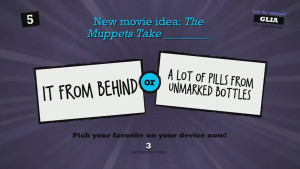 As I mentioned earlier (see my Funniest award runner-up award), we played this at pretty much every social gathering during the second half of 2015, and it never failed to be a hit. Two people answer a prompt (e.g, “A good catchphrase to yell every time you finish pooping”) through the game’s web browser interface on a cell phone, and then all other players use their phones to vote on which answer they like the best. It’s a simple concept that’s executed really well, and Jackbox Games even released an expansion for the game’s library of prompts that includes contributions from online users. If they’d only let you add custom prompts to your own copy of the game, it’d be perfect.
As I mentioned earlier (see my Funniest award runner-up award), we played this at pretty much every social gathering during the second half of 2015, and it never failed to be a hit. Two people answer a prompt (e.g, “A good catchphrase to yell every time you finish pooping”) through the game’s web browser interface on a cell phone, and then all other players use their phones to vote on which answer they like the best. It’s a simple concept that’s executed really well, and Jackbox Games even released an expansion for the game’s library of prompts that includes contributions from online users. If they’d only let you add custom prompts to your own copy of the game, it’d be perfect.
- Shovel Knight: Plague of Shadows
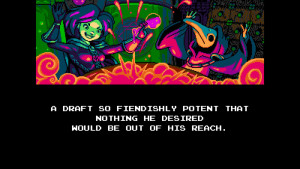 After beating the original game, I imagined a sequel that featured Shovel Knight teaming up with the former members of the Order of No Quarter in a character-swapping system akin to Castlevania III’s. Plague of Shadows lets you play as the bomb-tossing alchemist Plague Knight, complete with all of his abilities and a brand-new moveset, so it’s a step in the right direction for my dream sequel. While it does take you once again through the same levels, adding alternate routes to a few of them to accommodate Plague Knight’s different control scheme, this expansion has its own full story that plays out behind-the-scenes – literally, as you will see Shovel Knight running by in the background of certain areas – of the original narrative. It’s a bit like Back to the Future II, when Marty has returned to 1955 from the future while the original Marty is still there. You’ll duel with the other knights of the Order, and even square off against Shovel Knight in the Explodatorium level, letting you play the other side of Plague Knight’s original boss battle. Plague of Shadows packs just as much charm as the original game, letting you spend some time with tertiary characters and fleshing out the game’s world a bit more. If this is the bar that’s been set, then I am genuinely excited for the other two expansions for King Knight and Spectre Knight promised by Yacht Club Games.
After beating the original game, I imagined a sequel that featured Shovel Knight teaming up with the former members of the Order of No Quarter in a character-swapping system akin to Castlevania III’s. Plague of Shadows lets you play as the bomb-tossing alchemist Plague Knight, complete with all of his abilities and a brand-new moveset, so it’s a step in the right direction for my dream sequel. While it does take you once again through the same levels, adding alternate routes to a few of them to accommodate Plague Knight’s different control scheme, this expansion has its own full story that plays out behind-the-scenes – literally, as you will see Shovel Knight running by in the background of certain areas – of the original narrative. It’s a bit like Back to the Future II, when Marty has returned to 1955 from the future while the original Marty is still there. You’ll duel with the other knights of the Order, and even square off against Shovel Knight in the Explodatorium level, letting you play the other side of Plague Knight’s original boss battle. Plague of Shadows packs just as much charm as the original game, letting you spend some time with tertiary characters and fleshing out the game’s world a bit more. If this is the bar that’s been set, then I am genuinely excited for the other two expansions for King Knight and Spectre Knight promised by Yacht Club Games.
- Heroes of the Storm
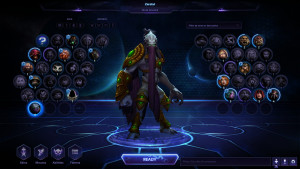 MOBAs in general haven’t really been my bag. It seems like if you want to be successful at them, you need to study every single character so you know how to counter everything, and study very specific strategies that you need to strictly adhere to every round or else you’ll ruin your team’s chances and end up suffering unfathomable hatred from people taking their video game way too fucking seriously. My stint with League of Legends was brief; the community was overly toxic, I never quite got the hang of any particular hero, and things felt too repetitive overall really early on for me. Awesomenauts was my go-to MOBA for several years after dropping LoL, but eventually the dwindling player base would lead to poor matchmaking, so regardless of your rank you’d find yourself in matches against people who were either way under or way over your level (whoever was available at all, basically). When Heroes of the Storm came along, I had low expectations. I figured I’d play a few rounds, get called awful names by shitty people, fail to understand yet again why my character seemed to do little to no damage to anything around it, then uninstall it. What I wasn’t expecting was to play through five rounds in a row my first night and feel like I actually had a lot of fun. The whole experience is streamlined; characters are pretty easy to understand and build out during rounds, and earning new ones for some reason doesn’t feel as incredibly tedious as it did in LoL. There’s a bit of actual variety to gameplay, too, delivered through multiple maps that each feature variations of sub-objectives and events that end up being very important for your team to work together on. This is a really nice changeup from just repeatedly playing the same one map looking for players to make the same sorts of mistakes that usually lead to an overwhelming defeat. I’ve seen a number of matches in HoTS turn completely around despite the number of hero deaths on either side, which is great since it’s less likely that you can become the sole reason why your team lost. I’m very impressed overall, and always seem to have a good time whether our team wins or loses.
MOBAs in general haven’t really been my bag. It seems like if you want to be successful at them, you need to study every single character so you know how to counter everything, and study very specific strategies that you need to strictly adhere to every round or else you’ll ruin your team’s chances and end up suffering unfathomable hatred from people taking their video game way too fucking seriously. My stint with League of Legends was brief; the community was overly toxic, I never quite got the hang of any particular hero, and things felt too repetitive overall really early on for me. Awesomenauts was my go-to MOBA for several years after dropping LoL, but eventually the dwindling player base would lead to poor matchmaking, so regardless of your rank you’d find yourself in matches against people who were either way under or way over your level (whoever was available at all, basically). When Heroes of the Storm came along, I had low expectations. I figured I’d play a few rounds, get called awful names by shitty people, fail to understand yet again why my character seemed to do little to no damage to anything around it, then uninstall it. What I wasn’t expecting was to play through five rounds in a row my first night and feel like I actually had a lot of fun. The whole experience is streamlined; characters are pretty easy to understand and build out during rounds, and earning new ones for some reason doesn’t feel as incredibly tedious as it did in LoL. There’s a bit of actual variety to gameplay, too, delivered through multiple maps that each feature variations of sub-objectives and events that end up being very important for your team to work together on. This is a really nice changeup from just repeatedly playing the same one map looking for players to make the same sorts of mistakes that usually lead to an overwhelming defeat. I’ve seen a number of matches in HoTS turn completely around despite the number of hero deaths on either side, which is great since it’s less likely that you can become the sole reason why your team lost. I’m very impressed overall, and always seem to have a good time whether our team wins or loses.
- Rocket League
 I have lost whole evenings to this game. It’s such a simple concept: soccer, with cars that can jump and boost, in an enclosed arena whose walls you can drive on. I think what really makes it so much fun is the control that you have over your vehicle. Cars handle fluidly; you can jump and boost in various directions to perform dodges and kicks, plus tilt your car in any direction while in the air. This means that there is the potential for you to be able to do anything, but pulling off any specific move at any given time requires really good timing and an ability to read where the ball is, is going, and will go. In other words, it’s not easy at all, especially given the speed of the game and short length of the matches. It basically becomes all about just doing your best to try to pull off moves, and recovering from wherever you end up flying off to as quickly as possible all while everyone else is doing the same. And once it’s all over, you’re just a short countdown away from doing it all again, so why not just one more match…
I have lost whole evenings to this game. It’s such a simple concept: soccer, with cars that can jump and boost, in an enclosed arena whose walls you can drive on. I think what really makes it so much fun is the control that you have over your vehicle. Cars handle fluidly; you can jump and boost in various directions to perform dodges and kicks, plus tilt your car in any direction while in the air. This means that there is the potential for you to be able to do anything, but pulling off any specific move at any given time requires really good timing and an ability to read where the ball is, is going, and will go. In other words, it’s not easy at all, especially given the speed of the game and short length of the matches. It basically becomes all about just doing your best to try to pull off moves, and recovering from wherever you end up flying off to as quickly as possible all while everyone else is doing the same. And once it’s all over, you’re just a short countdown away from doing it all again, so why not just one more match…
- The Legend of Zelda: Majora’s Mask 3D
 I love this game, despite its many flaws. The concept is ambitious and the execution is mostly great, especially when you consider just how much is going on and how ridiculous the game must have been to plan. The result is a very challenging experience that manages to deliver a decent ‘departure adventure’ to the series without changing things too much and going full-on Zelda 2 on us. The narrative is utterly depressing and dark, as the end of the world looms over everything at all times and the whole ordeal is set in motion in the first place by the actions of a very lonely outcast character. The Skull Kid ends up possessed by Majora’s Mask (a mask used during sacrificial ceremonies and chock full of bad juju) while trying to just make and hold on to friends, and there’s a sequence just before the last boss battle where you explore his depression before squaring off against the full-on rage of the evil contained within Majora’s Mask. I just love that it’s all about a personal adventure for Link, where he’s pulled into a situation where he’s compelled to be the hero rather than having been predestined to save the land.
I love this game, despite its many flaws. The concept is ambitious and the execution is mostly great, especially when you consider just how much is going on and how ridiculous the game must have been to plan. The result is a very challenging experience that manages to deliver a decent ‘departure adventure’ to the series without changing things too much and going full-on Zelda 2 on us. The narrative is utterly depressing and dark, as the end of the world looms over everything at all times and the whole ordeal is set in motion in the first place by the actions of a very lonely outcast character. The Skull Kid ends up possessed by Majora’s Mask (a mask used during sacrificial ceremonies and chock full of bad juju) while trying to just make and hold on to friends, and there’s a sequence just before the last boss battle where you explore his depression before squaring off against the full-on rage of the evil contained within Majora’s Mask. I just love that it’s all about a personal adventure for Link, where he’s pulled into a situation where he’s compelled to be the hero rather than having been predestined to save the land.
- Game of Thrones – A Telltale Games Series
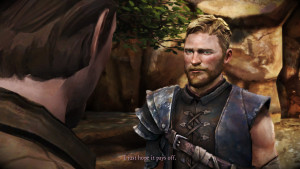 For as frustrating as I found this game’s story, it gets credit for being able to make me feel that frustrated. I mostly enjoyed this game for the opportunity to have a little more Game of Thrones in my life, though I have to say that I would have appreciated it more had it been a fully fleshed-out adventure game. The current state of Telltale’s games is disappointing; whereas a few years ago we still had titles like Back to the Future offering actual puzzles and inventories and more of a classic adventure game feel, these days the experiences delivered through Game of Thrones, The Walking Dead, and Wolf Among Us seem aimed at delivering those bland mobile experiences I complained about earlier in my writeup of Oceanhorn: Monster of Uncharted Seas (see my Most Disappointing award runner-up). If it can’t be played on an iPad with a bit of tapping and swiping, then it’ll never bring in those big mobile gaming dollars, so water that interface down! Game of Thrones still left a lasting impression and at least compelled me toward a second playthrough, but I’m not likely to give a GoTY nod to any more Telltale games if they stick with this formula.
For as frustrating as I found this game’s story, it gets credit for being able to make me feel that frustrated. I mostly enjoyed this game for the opportunity to have a little more Game of Thrones in my life, though I have to say that I would have appreciated it more had it been a fully fleshed-out adventure game. The current state of Telltale’s games is disappointing; whereas a few years ago we still had titles like Back to the Future offering actual puzzles and inventories and more of a classic adventure game feel, these days the experiences delivered through Game of Thrones, The Walking Dead, and Wolf Among Us seem aimed at delivering those bland mobile experiences I complained about earlier in my writeup of Oceanhorn: Monster of Uncharted Seas (see my Most Disappointing award runner-up). If it can’t be played on an iPad with a bit of tapping and swiping, then it’ll never bring in those big mobile gaming dollars, so water that interface down! Game of Thrones still left a lasting impression and at least compelled me toward a second playthrough, but I’m not likely to give a GoTY nod to any more Telltale games if they stick with this formula.
- Destiny: The Taken King
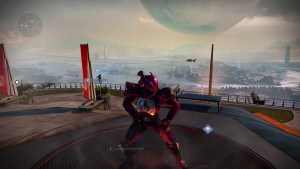 Jon sold me on this game by telling me that given how much we played and enjoyed Halo, he was pretty sure I’d like Destiny. That was the most accurate pitch he could really give, as Destiny more or less is a Halo MMO-lite. I had a week or so to play the original pre-Taken King content thanks to my pre-order of the expansion, and I agree with the majority of the community who think the game really improved with the update. There’s actual story content that’s interesting and fun to explore, the core mechanics of the game were reworked and streamlined, and Bungie started running in-game events that provide more variety and breaks in the regular daily grind – should you stick with it daily, that is. Destiny seems perfectly happy to be the game that you come back and play when there’s more to do rather than expecting you to be back every single day, but there’s plenty for you if you are a daily player.
Jon sold me on this game by telling me that given how much we played and enjoyed Halo, he was pretty sure I’d like Destiny. That was the most accurate pitch he could really give, as Destiny more or less is a Halo MMO-lite. I had a week or so to play the original pre-Taken King content thanks to my pre-order of the expansion, and I agree with the majority of the community who think the game really improved with the update. There’s actual story content that’s interesting and fun to explore, the core mechanics of the game were reworked and streamlined, and Bungie started running in-game events that provide more variety and breaks in the regular daily grind – should you stick with it daily, that is. Destiny seems perfectly happy to be the game that you come back and play when there’s more to do rather than expecting you to be back every single day, but there’s plenty for you if you are a daily player.
- Fallout 4
 After hearing so much about how everyone loves this series, particularly Fallout 3 and Fallout 3: New Vegas, I was excited to finally be diving in. Its previous entries lost to Steam Library Limbo, and after having sat out The Witcher III partially because I wanted to play its predecessors, I was determined to be on board for Fallout 4 (plus I scored one of those Pip Boy props with my pre-order). I really liked what I played, but found it very challenging. There never seems to be enough ammo, and I’m constantly a heartbeat away from death – but that’s how it should be in a post-apocalyptic wasteland, right? I also have a soft spot in my heart for the art deco style prominent in the 1950s, featured in this game in somewhat of a retro-future where the 1950s managed to last into the 2200s. There’s a ton to explore, although as with many other open-world games this means that the main storyline can be altogether forgotten, which is somewhat positive here since it’s not very compelling. There are tons of glitches and bugs, but I was expecting this from everything I’ve seen out of past titles, and don’t find them to be as terrible as some people do (although Nanners has my full sympathy for encountering a fully game-breaking issue after already investing a significant amount of time in it; I’d be pretty done with the game in that case, too).
After hearing so much about how everyone loves this series, particularly Fallout 3 and Fallout 3: New Vegas, I was excited to finally be diving in. Its previous entries lost to Steam Library Limbo, and after having sat out The Witcher III partially because I wanted to play its predecessors, I was determined to be on board for Fallout 4 (plus I scored one of those Pip Boy props with my pre-order). I really liked what I played, but found it very challenging. There never seems to be enough ammo, and I’m constantly a heartbeat away from death – but that’s how it should be in a post-apocalyptic wasteland, right? I also have a soft spot in my heart for the art deco style prominent in the 1950s, featured in this game in somewhat of a retro-future where the 1950s managed to last into the 2200s. There’s a ton to explore, although as with many other open-world games this means that the main storyline can be altogether forgotten, which is somewhat positive here since it’s not very compelling. There are tons of glitches and bugs, but I was expecting this from everything I’ve seen out of past titles, and don’t find them to be as terrible as some people do (although Nanners has my full sympathy for encountering a fully game-breaking issue after already investing a significant amount of time in it; I’d be pretty done with the game in that case, too).
- Undertale
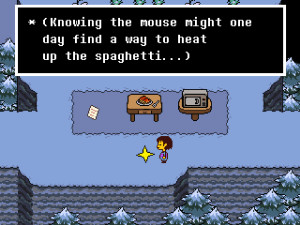 Undertale seems to be a highly polarizing title. Speaking for myself, I love it for the whole and complete experience: presented as a retro RPG, the NES/SNES-style sprite art looks a lot like the Mother series, featuring fantastic character designs and a whole lot of charm. The soundtrack is absolutely amazing (see my Best Soundtrack award), the gameplay is a nice change of pace from strictly turn-based style RPGs, the writing features great humor (see my Funniest award) and the story is very interesting and satisfying overall, although it does seem like it’s paced a little oddly with the bulk of information coming to you later on. It also features a number of meta experiences you encounter when doing things like reloading your game and repeating interactions with certain characters, and a lot of this is tied into the multitude of endings you can receive based on various choices you make, giving a bit of depth to the whole experience. That said, I feel like if any one of these components doesn’t jive for you, then you land squarely in the camp of people who absolutely hate the game. Not being as captivated by Undertale as its very vocal fanbase while being unable to escape their constant praising of it seems to be a common complaint. If you’re uninitiated, though, then it’s absolutely worth giving a chance.
Undertale seems to be a highly polarizing title. Speaking for myself, I love it for the whole and complete experience: presented as a retro RPG, the NES/SNES-style sprite art looks a lot like the Mother series, featuring fantastic character designs and a whole lot of charm. The soundtrack is absolutely amazing (see my Best Soundtrack award), the gameplay is a nice change of pace from strictly turn-based style RPGs, the writing features great humor (see my Funniest award) and the story is very interesting and satisfying overall, although it does seem like it’s paced a little oddly with the bulk of information coming to you later on. It also features a number of meta experiences you encounter when doing things like reloading your game and repeating interactions with certain characters, and a lot of this is tied into the multitude of endings you can receive based on various choices you make, giving a bit of depth to the whole experience. That said, I feel like if any one of these components doesn’t jive for you, then you land squarely in the camp of people who absolutely hate the game. Not being as captivated by Undertale as its very vocal fanbase while being unable to escape their constant praising of it seems to be a common complaint. If you’re uninitiated, though, then it’s absolutely worth giving a chance.
- Super Mario Maker
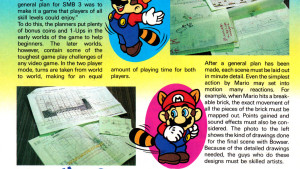 The January 1990 issue of Nintendo Power ran a preview of Super Mario Bros. 3, which was due out in North America the following month. In it, the magazine explored the process for making NES Mario games with Shigeru Miyamoto and his team at Nintendo’s Kyoto headquarters. This article contained photos featuring, among other things, piles of drawings and designs for the final game, and one pile in particular blew my eight year-old mind: it showed the final Bowser confrontation drawn on graph paper. “You can use graph paper to make video games?!” It made sense, though; everything was laid out in tiles, and drawing that out on graph paper was a natural solution. I immediately acquired a pad of graph paper and designed many Mario levels and whole NES games that would never be made – something I’m certain many kids did in the 90s.
The January 1990 issue of Nintendo Power ran a preview of Super Mario Bros. 3, which was due out in North America the following month. In it, the magazine explored the process for making NES Mario games with Shigeru Miyamoto and his team at Nintendo’s Kyoto headquarters. This article contained photos featuring, among other things, piles of drawings and designs for the final game, and one pile in particular blew my eight year-old mind: it showed the final Bowser confrontation drawn on graph paper. “You can use graph paper to make video games?!” It made sense, though; everything was laid out in tiles, and drawing that out on graph paper was a natural solution. I immediately acquired a pad of graph paper and designed many Mario levels and whole NES games that would never be made – something I’m certain many kids did in the 90s.
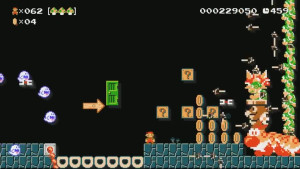 Twenty-five years later, Nintendo would give everyone in the world the ultimate pad of graph paper and the chance to finally make their own Mario levels. The result would be glorious. This isn’t just a barebones level editor that lets you take ‘the normal Mario stuff’ and build levels just like what you’ve already played in past games. You absolutely can do that, if you want, but the tools provided in Super Mario Maker are designed to let you go well beyond the same-old-same-old so that the levels you’ll play and share provide brand new experiences. You start by choosing an aesthetic, utilizing a tileset from either Super Mario Bros. 1, 3, World, or the New Super Mario Bros. games. You can set up functional warp pipes and doors, and tile out the environment as if you were stamping things onto a piece of graph paper. The game lets you place enemies and alter them in all sorts of new ways, stacking them or making them super large or adding wings to them. Wings can be added to pretty much anything, actually, and almost anything can be placed inside question mark blocks instead of just power-ups or coins. You’re given an incredible amount of control over your level, and offered a really impressive number of options for altering assets in ways in which they were never used in their original games. The built-in course sharing system has improved a bit over its rough start, but in the end you’re playing Mario levels created by people all over the world of all ages, so you’re going to get a lot of variation in quality. But you can basically stream in endless Mario levels, and that’s amazing in itself.
Twenty-five years later, Nintendo would give everyone in the world the ultimate pad of graph paper and the chance to finally make their own Mario levels. The result would be glorious. This isn’t just a barebones level editor that lets you take ‘the normal Mario stuff’ and build levels just like what you’ve already played in past games. You absolutely can do that, if you want, but the tools provided in Super Mario Maker are designed to let you go well beyond the same-old-same-old so that the levels you’ll play and share provide brand new experiences. You start by choosing an aesthetic, utilizing a tileset from either Super Mario Bros. 1, 3, World, or the New Super Mario Bros. games. You can set up functional warp pipes and doors, and tile out the environment as if you were stamping things onto a piece of graph paper. The game lets you place enemies and alter them in all sorts of new ways, stacking them or making them super large or adding wings to them. Wings can be added to pretty much anything, actually, and almost anything can be placed inside question mark blocks instead of just power-ups or coins. You’re given an incredible amount of control over your level, and offered a really impressive number of options for altering assets in ways in which they were never used in their original games. The built-in course sharing system has improved a bit over its rough start, but in the end you’re playing Mario levels created by people all over the world of all ages, so you’re going to get a lot of variation in quality. But you can basically stream in endless Mario levels, and that’s amazing in itself.
 The main complaint I hear about Super Mario Maker is that it’s just laziness on Nintendo’s part, and that they ‘don’t even have to do anything’ while the fans shoulder all the work. This is just simply not the case at all. As a level editor, it’s very robust and has a lot of features they didn’t have to include if they just wanted to dump out a basic tool and call it a day – not to mention they’ve added functionality to it since launch. I’ve also heard people accuse Nintendo of ‘just ripping off other people’s ideas’ and normally citing Kaizo Mario with that argument, and I’m not certain what to make of this. Nintendo ripped off people making ROM hacks of Nintendo’s own games by giving them official tools with which to make their own levels? I don’t see a negative, here; if anything it’s an acknowledgement by Nintendo of how impressive some ROM hacks are, and an embracing the fanbase creating them. Not to mention this opens the whole idea up to people who aren’t coding geniuses and can’t make their own ROM hacks. Super Mario Maker is a very positive thing to come out of gaming, and we’re better off for it existing. Hopefully it’ll inspire other companies to make such editing tools more readily available.
The main complaint I hear about Super Mario Maker is that it’s just laziness on Nintendo’s part, and that they ‘don’t even have to do anything’ while the fans shoulder all the work. This is just simply not the case at all. As a level editor, it’s very robust and has a lot of features they didn’t have to include if they just wanted to dump out a basic tool and call it a day – not to mention they’ve added functionality to it since launch. I’ve also heard people accuse Nintendo of ‘just ripping off other people’s ideas’ and normally citing Kaizo Mario with that argument, and I’m not certain what to make of this. Nintendo ripped off people making ROM hacks of Nintendo’s own games by giving them official tools with which to make their own levels? I don’t see a negative, here; if anything it’s an acknowledgement by Nintendo of how impressive some ROM hacks are, and an embracing the fanbase creating them. Not to mention this opens the whole idea up to people who aren’t coding geniuses and can’t make their own ROM hacks. Super Mario Maker is a very positive thing to come out of gaming, and we’re better off for it existing. Hopefully it’ll inspire other companies to make such editing tools more readily available.


You must be logged in to post a comment.